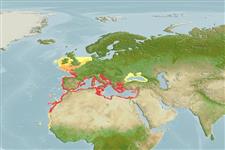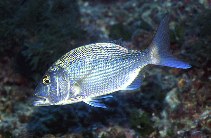Adicionar sua observação em Fish Watcher
| Native range | All suitable habitat | Point map | Year 2050 |

|
| This map was computer-generated and has not yet been reviewed. |
| Dentex dentex AquaMaps Data sources: GBIF OBIS |
Carregue seu(sua) Fotos e vídeos
Pictures | Videos | Stamps, coins, misc. | Imagem do GoogleDentex dentex
Picture by Patzner, R.
Pictures | Videos | Stamps, coins, misc. | Imagem do GoogleDentex dentex
Picture by Patzner, R.
Egypt country information
Common names:
Addad, Basas
Occurrence: native
Salinity: marine
Abundance: | Ref:
Importance: | Ref:
Aquaculture: | Ref:
Regulations: | Ref:
Uses: no uses
Comments: Also Ref. 95541.
National Checklist:
Country Information: https://www.cia.gov/library/publications/resources/the-world-factbook/geos/eg.html
National Fisheries Authority:
Occurrences: Occurrences Point map
Main Ref: Bauchot, M.-L., 1987
National Database:
Occurrence: native
Salinity: marine
Abundance: | Ref:
Importance: | Ref:
Aquaculture: | Ref:
Regulations: | Ref:
Uses: no uses
Comments: Also Ref. 95541.
National Checklist:
Country Information: https://www.cia.gov/library/publications/resources/the-world-factbook/geos/eg.html
National Fisheries Authority:
Occurrences: Occurrences Point map
Main Ref: Bauchot, M.-L., 1987
National Database:
Common names from other countries
Classificação / Names Nomes comuns | Sinônimos | Catalog of Fishes(Gênero, Espécies) | ITIS | CoL | WoRMS | Cloffa
> Eupercaria/misc (Various families in series Eupercaria) > Sparidae (Porgies)
Etymology: Dentex: Latin, dens, dentis = teeth (Ref. 45335).
More on author: Linnaeus.
Etymology: Dentex: Latin, dens, dentis = teeth (Ref. 45335).
More on author: Linnaeus.
Environment: milieu / climate zone / depth range / distribution range Ecologia
marinhas bentopelágico; intervalo de profundidade 0 - 200 m (Ref. 3688), usually 15 - 50 m (Ref. 54220). Subtropical; 56°N - 12°N, 23°W - 42°E (Ref. 54220)
Distribuição Países | Áreas da FAO | Ecossistemas | Ocorrências | Point map | Introduções | Faunafri
Eastern Atlantic: British Isles to Cape Blanc, Mauritania; (exceptionally further south) Senegal and around the Canary Islands and Madeira. Common south of 40°N (Spain, North Africa) in the Mediterranean (Ref. 4781).
Comprimento de primeira maturação / Tamanho / Peso / Idade
Maturity: Lm 34.6 range ? - ? cm
Max length : 100.0 cm TL macho/indeterminado; (Ref. 3397); common length : 50.0 cm TL macho/indeterminado; (Ref. 3688); peso máx. publicado: 14.3 kg (Ref. 40637)
Max length : 100.0 cm TL macho/indeterminado; (Ref. 3397); common length : 50.0 cm TL macho/indeterminado; (Ref. 3688); peso máx. publicado: 14.3 kg (Ref. 40637)
Descrição suscinta Chaves de identificação | Morfologia | Morfometria
Espinhos dorsais (total) : 11; Raios dorsais (total) : 11 - 12; Espinhos anais: 3; Raios anais : 7 - 9. Body oval and compressed. Canine teeth, with 4 to 6 anterior teeth very developed in each jaw.
Inhabit hard bottoms (rock or rubble) down to 200 m depth. Usually found in shallow water less than 50 m deep (Ref. 9987). Adults solitary; young gregarious (Ref. 12482). Young fish caught with traps. Feed on fish, mollusks and cephalopods. Important food fish. Marketed fresh or frozen (Ref. 9987). Some attempts to culture this species have been successful. Due to low market supply, the potential for selling these fish from aquaculture operations seems to be good (Ref. 9987). A spear-fisherman cites a specimen caught in Greece (Corfu) with an overnight bottom-line about 1.60 m and 42 kg (Ref. 48271), but the identification cannot be verified.
Ciclo de vida ou comportamento de acasalamento Maturidade | Reprodução | Desova | Ovos | Fecundidade | Larvas
Gonochoric, but some specimens are hermaphroditic. Species of separated sexes (although some individuals may be hermaphrodite in young stages). In the Mediterranean, reproduction takes place between March and May, in areas near the coast. Embryo development lasts about 3 days at 17°C.
Referência principal
Upload your references | Referências | Coordenador | Colaboradores
Bauchot, M.-L. and J.-C. Hureau, 1990. Sparidae. p. 790-812. In J.C. Quero, J.C. Hureau, C. Karrer, A. Post and L. Saldanha (eds.) Check-list of the fishes of the eastern tropical Atlantic (CLOFETA). JNICT, Lisbon; SEI, Paris; and UNESCO, Paris. Vol. 2. (Ref. 3688)
Status na Lista Vermelha da UICN (Ref. 130435: Version 2024-2)
Vulnerável, ver Livro Vermelho da UICN (VU) (A2bd); Date assessed: 17 August 2009
Ameaça para os humanos
Harmless
Uso pelos humanos
Pescarias: espécies comerciais; Aquacultura: espécies comerciais; peixe esportivo: sim
FAO(Aquaculture systems: produção; pescarias: produção, perfil da espécie; publication : search) | FIRMS (Stock assessments) | FishSource | Sea Around Us
Mais informação
Population dynamics
Parâmetros de crescimento
Max. ages / sizes
Length-weight rel.
Length-length rel.
Frequências de comprimento
Conversão de massa
Recrutamento
Abundância
Parâmetros de crescimento
Max. ages / sizes
Length-weight rel.
Length-length rel.
Frequências de comprimento
Conversão de massa
Recrutamento
Abundância
Life cycle
Reprodução
Maturidade
Fecundidade
Desova
Spawning aggregations
Ovos
Desenvolvimento dos ovos
Larvas
Dinâmica larval
Reprodução
Maturidade
Fecundidade
Desova
Spawning aggregations
Ovos
Desenvolvimento dos ovos
Larvas
Dinâmica larval
Anatomy
Área branquial
Brain
Otolith
Área branquial
Brain
Otolith
Physiology
Body composition
Nutrients
Consumo de oxigênio
Tipo de natação
Velocidade de natação
Visual pigments
Fish sound
Diseases & Parasites
Toxicity (LC50s)
Body composition
Nutrients
Consumo de oxigênio
Tipo de natação
Velocidade de natação
Visual pigments
Fish sound
Diseases & Parasites
Toxicity (LC50s)
Genetics
Genética
Heterozygosity
Hereditariedade
Genética
Heterozygosity
Hereditariedade
Human related
Aquaculture systems
Perfis para aquacultura
Estirpes
Ciguatera cases
Stamps, coins, misc.
Aquaculture systems
Perfis para aquacultura
Estirpes
Ciguatera cases
Stamps, coins, misc.
Ferramentas
Bio-Quiz | Livro eletrônico | Guia de campo | Ferramenta auxiliar de frequências de comprimento | Ferramenta sobre a história de vida | Mapa de pontos | Classification Tree
| Catch-MSY |
Relatórios especiais
Checar Manutenção em Aquário | Checar Planilhas de Fatos sobre as Espécies | Checar Planilhas de Fatos sobre Aquicultura
Baixar XML
Fontes da internet
Aquatic Commons | BHL | Cloffa | Websites from users | Checar Observador de Peixes (FishWatcher) | CISTI | Catalog of Fishes(Gênero, Espécies) | DiscoverLife | DORIS | ECOTOX | Faunafri | Fishtrace | GenBank(genoma, nucleotídeo) | GloBI | GOBASE | | Google Books | Google Scholar | Google | IGFA World Record | MitoFish | Bases de dados nacionais | Otolith Atlas of Taiwan Fishes | Aquários públicos | PubMed | Reef Life Survey | Scirus | SeaLifeBase | Árvore da vida | Wikipedia(Ir para, procura) | World Records Freshwater Fishing | Registro zoológico
Estimates based on models
Preferred temperature (Ref. 115969): 13.3 - 21.1, mean 18.1 (based on 298 cells).
Índice de diversidade filogenética (Ref. 82804): PD50 = 0.5001 [Uniqueness, from 0.5 = low to 2.0 = high].
Bayesian length-weight: a=0.01122 (0.00952 - 0.01322), b=3.03 (3.00 - 3.06), in cm Total Length, based on LWR estimates for this species (Ref. 93245).
Nível Trófico (Ref. 69278): 4.5 ±0.4 se; based on diet studies.
Resiliência (Ref. 120179): Baixo, tempo mínimo de duplicação da população 4,5 - 14 anos (K=0.1; tm=2-3).
Prior r = 0.39, 95% CL = 0.26 - 0.58, Based on 9 data-limited stock assessments.
Fishing Vulnerability (Ref. 59153): High to very high vulnerability (66 of 100).
Climate Vulnerability (Ref. 125649): High vulnerability (63 of 100).




